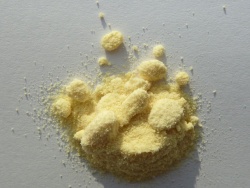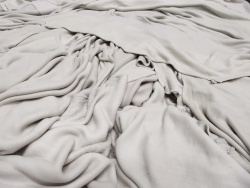Difference between revisions of "Synthetic tanned"
(Created page with "<p align=center> 300px </p> Als Alternative zur Chromgerbung wird häufig die synthetische Gerbung angewandt. '''Synthetische Gerbstoff...") |
|||
| Line 4: | Line 4: | ||
| − | + | Synthetic tanning is frequently used as an alternative to [[Chrome tanned|chrome tanning]]. | |
| − | + | Synthetic tanning agents (aromatic syntans) are produced artificially by man, so have no counterpart in nature. Examples of these include formaldehyde, glutaraldehyde (also known as glutaraldehyde), phenols and acrylates. Synthetic tanning method is not employed as an isolated [[Tanning leather|tanning process]], but mostly in a [[Tanning leather#Tanning methods|combination tanning process]] with either [[Chrome tanned|chrome tanning]] or [[Vegetable-tanned leather|vegetable tanning processes]]. Chrome leather production ensures retanning with synthetic tanning agents as they provide the necessary “fullness" to the leather. It is estimated that annual production of synthetic tanning agents amount to 200,000 tonnes (2008). | |
| − | + | After tanning, when the leather is still wet and not dyed, it gets a bright [[Leather colour|colour]] and hence is also referred to as [[Wet white|wet white]]. | |
| Line 16: | Line 16: | ||
</p> | </p> | ||
<p align=center> | <p align=center> | ||
| − | '' | + | ''Synthetic tanning agents - [[[[Wet white|Wet White]]''<br></p> |
<p> </p> | <p> </p> | ||
Revision as of 12:04, 17 September 2016
Synthetic tanning is frequently used as an alternative to chrome tanning.
Synthetic tanning agents (aromatic syntans) are produced artificially by man, so have no counterpart in nature. Examples of these include formaldehyde, glutaraldehyde (also known as glutaraldehyde), phenols and acrylates. Synthetic tanning method is not employed as an isolated tanning process, but mostly in a combination tanning process with either chrome tanning or vegetable tanning processes. Chrome leather production ensures retanning with synthetic tanning agents as they provide the necessary “fullness" to the leather. It is estimated that annual production of synthetic tanning agents amount to 200,000 tonnes (2008).
After tanning, when the leather is still wet and not dyed, it gets a bright colour and hence is also referred to as wet white.
Synthetic tanning agents - [[Wet White
Additional information
Film über die Lederherstellung
Filme über die Lederherstellung in der Gerberei
| Verfahren der Gerbung |
|---|
| Chromgerbung - Lohgerbung - Weißgerbung - Fettgerbung - Synthetische Gerbung |










 a kotori web solution
a kotori web solution